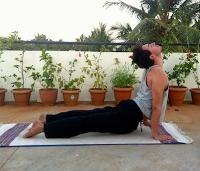Religion Major Studies Yoga in India
January 29, 2013
Liv Combe

At Oberlin, the period between fall and spring semester known as winter term is an opportunity for growth, reflection, and new experiences. Throughout the month, formal classes are suspended, and students have the option of completing a project of their choice for half or full credit. Regardless of the project, the central objective of winter term is to continue the process of personal and academic discovery outside the confines of a classroom.
Many people have not heard of the city of Mysore, but to certain practitioners of yoga, junior religion major Alexander Bianchi included, the metropolis in a southwestern state of India is a site of pilgrimage.
With the aid of an Oberlin Shansi In-Asia Study grant, Bianchi’s project, Becoming the Breath: a Critical Field Study of the Ashtanga Vinyasa Yoga Practice, has taken him to India for a month of practice and observation at the Sri K. Pattabhi Jois Ashtanga Yoga Institute. As the city where Sri K. Pattabhi Jois — the man responsible for spreading the practice around the world — lived and taught until his death in 2009, Mysore is considered the origin-place of Ashtanga yoga.
Bianchi, who has been practicing Ashtanga for two and a half years, describes the style of practice as “a breath-focused, flowing, physically demanding form of yoga,” one in which the practitioners learn set series of asanas (postures) in advancing order as a choreographed and flowing movement. Although Jois was widely considered to be the modern-day Ashtanga master, the practice is based on an ancient yoga tradition.
The institute has hundreds of certified Ashtanga teachers across the globe, but many practitioners still flock to Mysore to study at the wellspring of the practice.
Bianchi is focusing on the teaching methods of Ashtanga, taking daily observational field notes and conducting interviews with fellow practitioners and teachers about their personal histories with and relationships to the practice.
“There is an emphasis in this practice on tradition, on preserving the practice and teaching it ‘properly,’” says Bianchi. “Yet all over the world one finds a multiplicity of teachers, teaching styles, and interpretations of Ashtanga’s purpose and meaning.”
In the emerging field of modern yoga studies, researchers have found that many versions of contemporary yoga are a blend of Western and Indian thought and traditions. “This opposes the idea of contemporary yogas being the ancient, pristine traditions they are often said to be,” says Bianchi.
Rather than focus on this transformation or perceived break from the older yoga traditions, Bianchi says he wants to “look at the internal working of the Ashtanga lineage in which I practice,” noting that “not much has yet been published about types of modern yoga as established and developing traditions in their own right.”
Bianchi’s winter-term research will factor into his final capstone project, for which he hopes to conduct similar field studies in the United States. This spring, he will give an Ashtanga demonstration and lecture as a component of his Shansi grant.
You may also like…
Making a Difference with Business
Omukoko Okoth ’25 chose Oberlin College for its values and opportunities, and in order to take advantage of all that Oberlin has to offer, he decided to participate in the business integrative concentration.
Oberlin Musicians Collaborate at California’s Hidden Valley Institute
Winter Term projects culminate in performances involving TIMARA, dance, chamber music, and jazz.
Health for All
Annie Griffith turned to Montana to serve in a fellow Obie’s reproductive health clinic.


